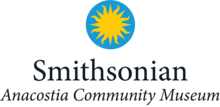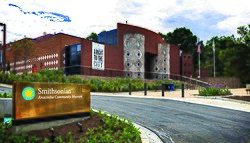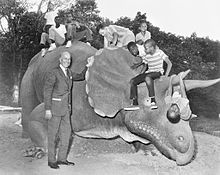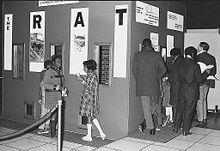
The Smithsonian Institution, or simply the Smithsonian, is a group of museums, education and research centers, the largest such complex in the world, created by the U.S. government "for the increase and diffusion of knowledge." Founded on August 10, 1846, it operates as a trust instrumentality and is not formally a part of any of the three branches of the federal government. The institution is named after its founding donor, British scientist James Smithson. It was originally organized as the United States National Museum, but that name ceased to exist administratively in 1967.

The Arthur M. Sackler Gallery is an art museum of the Smithsonian Institution in Washington, D.C., focusing on Asian art. The Sackler Gallery and the Freer Gallery of Art together form the National Museum of Asian Art in the United States. The Freer and Sackler galleries house the largest Asian art research library in the country.

The National Museum of Natural History (NMNH) is a natural history museum administered by the Smithsonian Institution, located on the National Mall in Washington, D.C., United States. It has free admission and is open 364 days a year. With 4.4 million visitors in 2023, it was the most-visited museum in the United States.

Cooper Hewitt, Smithsonian Design Museum is a design museum at the Andrew Carnegie Mansion in Manhattan, New York City, along the Upper East Side's Museum Mile. It is one of 19 Smithsonian Institution museums and one of three Smithsonian facilities located in New York City, along with the National Museum of the American Indian's George Gustav Heye Center in Bowling Green and the Archives of American Art New York Research Center in the Flatiron District. Unlike other Smithsonian museums, Cooper Hewitt charges an admissions fee. It is the only museum in the United States devoted to historical and contemporary design. Its collections and exhibitions explore design aesthetic and creativity from throughout the United States' history.

The Smithsonian American Art Museum is a museum in Washington, D.C., part of the Smithsonian Institution. Together with its branch museum, the Renwick Gallery, SAAM holds one of the world's largest and most inclusive collections of art, from the colonial period to the present, made in the United States. More than 7,000 artists are represented in the museum's collection. Most exhibitions are held in the museum's main building, the Old Patent Office Building, while craft-focused exhibitions are shown in the Renwick Gallery.

The National Museum of African Art is the Smithsonian Institution's African art museum, located on the National Mall of the United States capital. Its collections include 9,000 works of traditional and contemporary African art from both Sub-Saharan and North Africa, 300,000 photographs, and 50,000 library volumes. It was the first institution dedicated to African art in the United States and remains the largest collection. The Washington Post called the museum a mainstay in the international art world and the main venue for contemporary African art in the United States.

The National Museum of African American History and Culture (NMAAHC), colloquially known as the Blacksonian, is a Smithsonian Institution museum located on the National Mall in Washington, D.C., in the United States. It was established in 2003 and opened its permanent home in 2016 with a ceremony led by President Barack Obama.

Smithsonian Libraries and Archives is an institutional archives and library system comprising 21 branch libraries serving the various Smithsonian Institution museums and research centers. The Libraries and Archives serve Smithsonian Institution staff as well as the scholarly community and general public with information and reference support. Its collections number nearly 3 million volumes including 50,000 rare books and manuscripts.

Lonnie G. Bunch III is an American educator and historian. Bunch is the fourteenth secretary of the Smithsonian Institution, the first African American and first historian to serve as head of the Smithsonian. He has spent most of his career as a history museum curator and administrator.

John Robert Edward Kinard was an American social activist, pastor, and museum director. He is best known as the director of the Anacostia Museum, a small community museum founded by the Smithsonian Institution in 1967. Kinard was the museum's first director, and remained in the post until his death. The Washington Post said Kinard was "a passionate believer in the idea that the well-being of black people depends on having a record of their past". Noted British archeologist and museologist Sir Kenneth Hudson said Kinard "developed the Anacostia Museum into one of the small number of museums of influence in the world."

Louise Daniel Hutchinson was an American historian. She was the former Director of the Research at the Anacostia Community Museum. Growing up in Washington, D.C., Hutchinson was exposed to the Civil Rights Movement and the importance of community. Hutchinson worked closely with the African American community of Washington, D.C., and staff at the Smithsonian Institution to help build the Anacostia Community Museum. She was a historian of the Anacostia community.

Portia James was an American curator and historian. A specialist in African-American material culture, she worked as the cultural resources manager of the Anacostia Community Museum.

The Carver Theater is a former movie theater located in the Anacostia neighborhood of Washington, D.C. in the United States.
Michael Atwood Mason is an American folklorist and museum professional. He was CEO and Executive Director of President Lincoln's Cottage. Up to February 2021 he was the Director of the Smithsonian Center for Folklife and Cultural Heritage.
The Barnett-Aden Gallery was a nonprofit art gallery in Washington D.C., founded by James V. Herring and Alonzo J. Aden, who were associated with Howard University's art department and gallery. The gallery, which opened on October 16, 1943, and operated until 1969, was the first successful Black-owned private art gallery in the United States; showcased numerous important artists; and became an important, racially integrated part of the artistic and social worlds of 1940s and 1950s Washington, D.C.

Edith T. Martin is an American artist and museum professional.
A community museum is a museum serving as an exhibition and gathering space for specific identity groups or geographic areas.
Bruce McNeil was an American environmental fine arts photographer predominantly known for photographic work which has documented the Washington, DC area waterways. For over two decades his environmental photography has especially focused on documenting the Anacostia River. The Washington Examiner and The Washington Post have dubbed him as “DC River Man” and “Washington’s River Man.” He was the organizer of the Anacostia River School of Photography, "a ragtag group of a half-dozen photographers who either live or work in the neighborhood and are devoted to shooting the river and its environs."

Zora Martin-Felton was an American museum director and curator. She established the education department at the Anacostia Community Museum, which is a museum in the Smithsonian Institution and worked as Director of Education from 1967 to 1995.





















